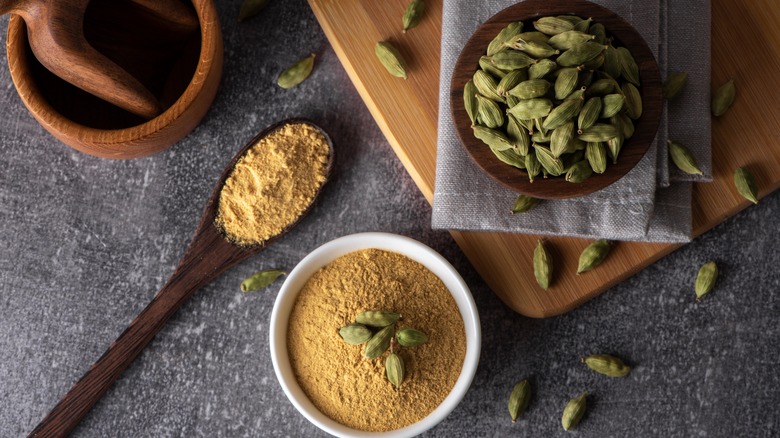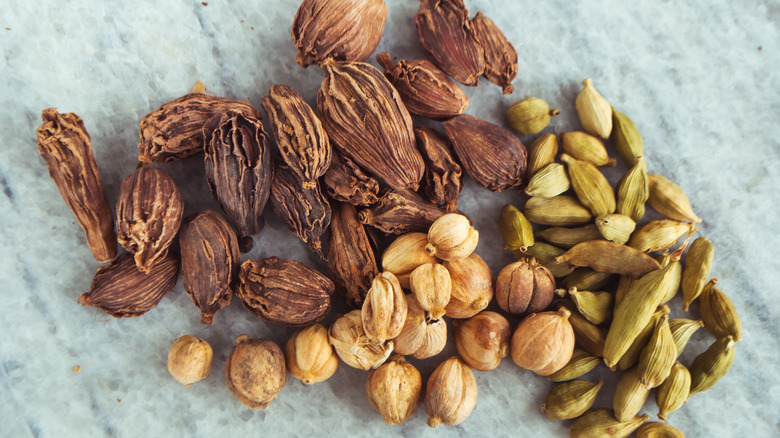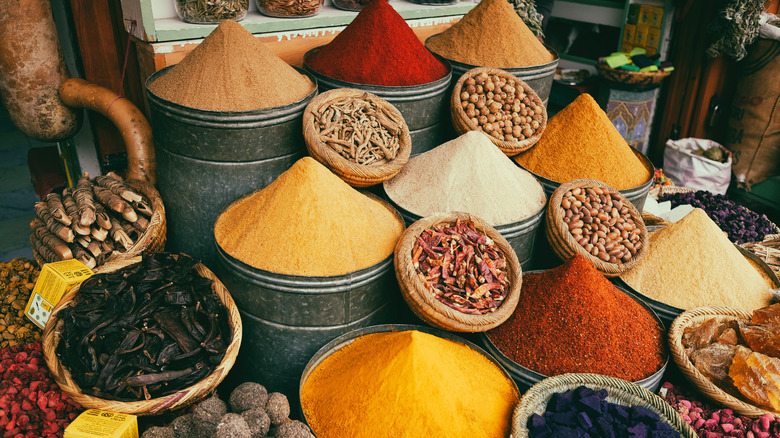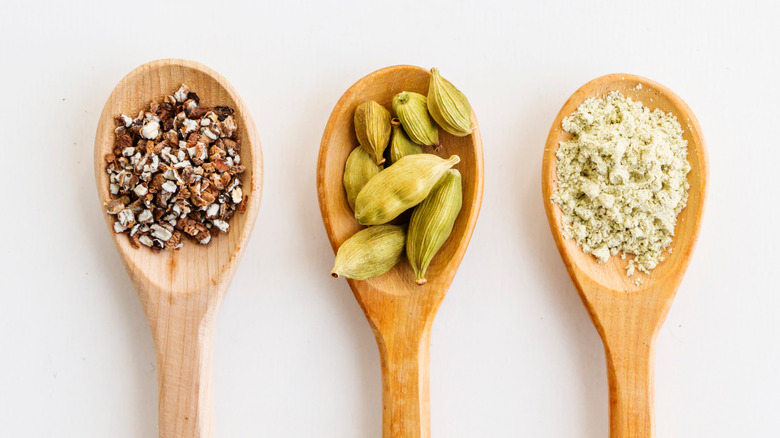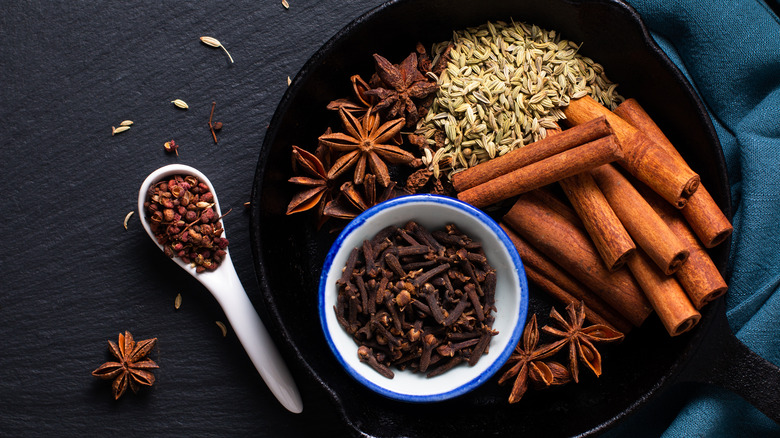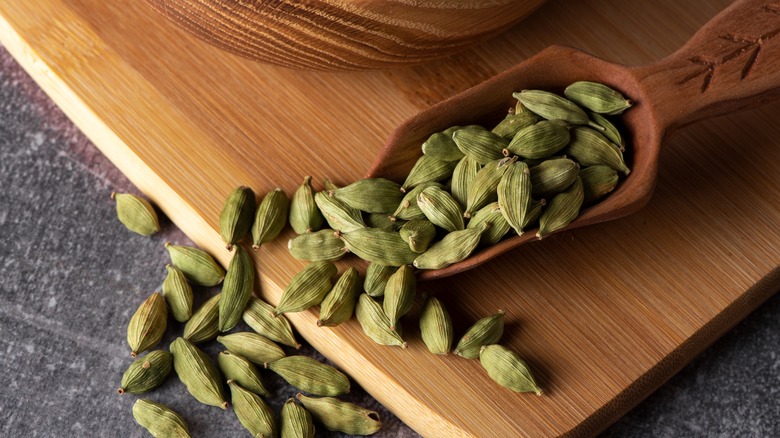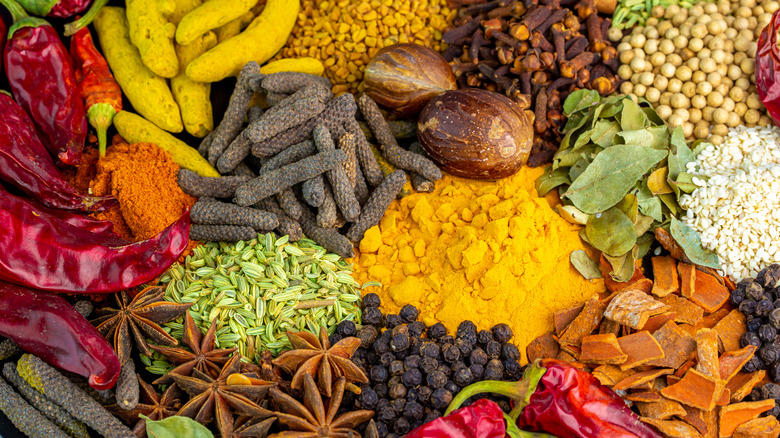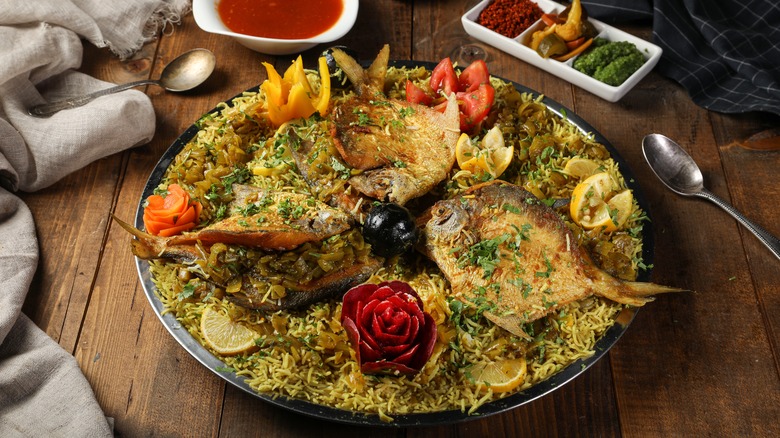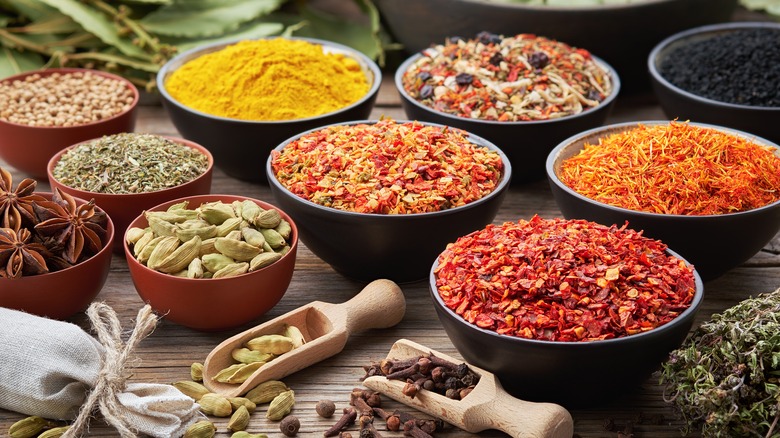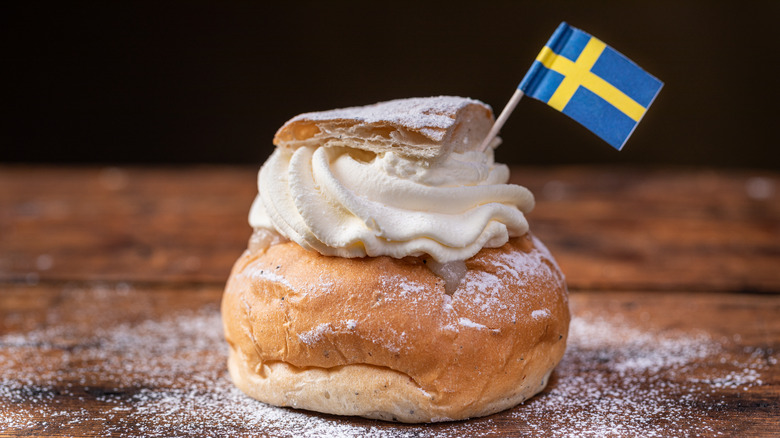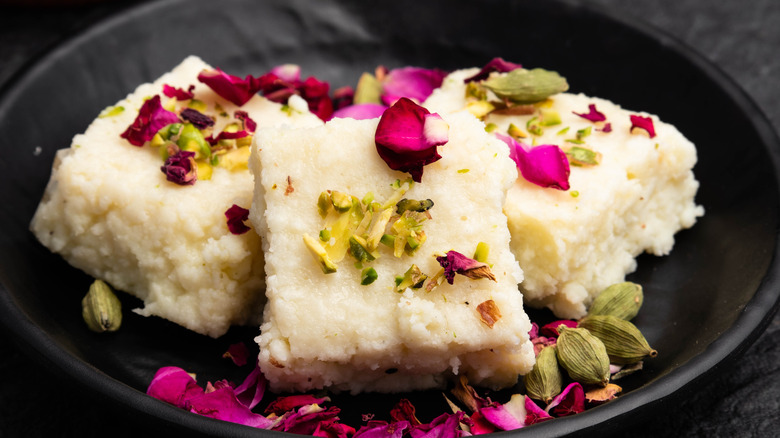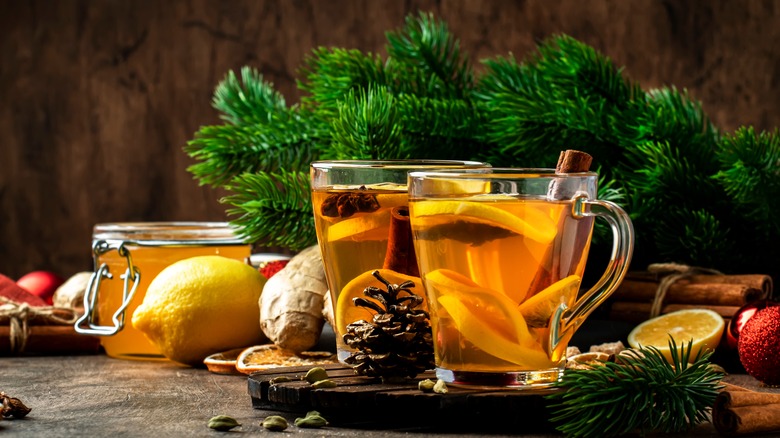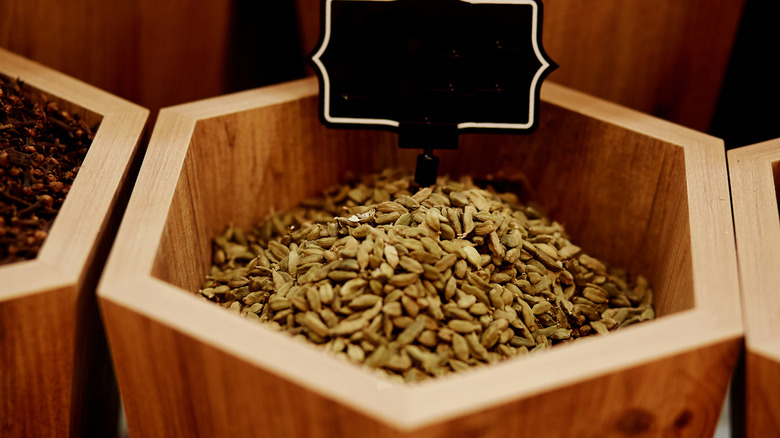The 12 Biggest Mistakes Everyone Makes When Cooking With Cardamom
If you're unfamiliar with the intricacy of cardamom's sweet and spicy warmth, hearing the name might only conjure vague ideas of curries and Indian takeout. It's commonly spelled cardamom or cardamon, but depending on your region, the spellings are interchangeable. Per Encyclopedia Britannica, cardamom is the fragrant dried seed pod of the plant Elettaria cardamomum. It's frequently found in Middle Eastern cuisine of all varieties, especially in stews and soups from every region of India. It's also no surprise there's a stereotype of cardamom being a spice exclusive to chai.
Though some chefs may consider cardamom a self-explanatory seed pod, it has a wealth of history and usage. Beyond curries, you can find cardamom in desserts across the world and as a complement to meats like lamb and beef in many cultures. For home chefs looking to expand their palates with cardamom, there are still a few common pitfalls to avoid.
Using the wrong type of cardamom
If you come across cardamom casually, you've likely found ground cardamom in a jar on grocery shelves. Before it becomes a jarred powder, cardamom has four distinct types. According to Spices Inc., green cardamom is the varietal that is most familiar to home cooks. This form of cardamom gets its name from the pods. They're light green and papery in texture and get picked by harvesters before fully ripe. Because of their small size, they're more potent in flavor and contain almost sticky seeds.
Many home chefs use black cardamom less than green cardamom, and the pods are actually brown. It's equally delicious, and many prefer black cardamom for cooking over baking. The seed pods also get roasted over a fire, giving them a richer smoky taste and an intensity that is better suited to savory foods.
Next comes red cardamom. You may also know red cardamom as false cardamom. Spices Inc. also notes that these seeds are larger than green and black cardamom. Finally, there's the elusive white cardamom. Per The Woks Of Life, white cardamom is most commonly used in Chinese recipes and dishes across Southeast Asia. These round plump seeds have a hard outer shell and give off a warm fragrance of lemon and mint when used in slow-cooked soups and curries.
Storing cardamom improperly
We've all seen aesthetic videos on TikTok or Instagram where an influencer fills stunning minimalistic glass jars with spices and herbs and then displays them in their brightly lit commercial kitchen. As beautiful as that system may be, it simply isn't the best for preserving the flavor and longevity of your seasonings. To keep your spices fresh, avoid airflow around your spices and keep herbs away from heat.
If you have the storage space to keep your cardamom in a cool, dry cabinet, that's ideal, but no matter what, keep them tightly sealed. Not willing to splurge on special spice storage in your kitchen? Storing cardamom pods or ground seeds in airtight metal or opaque dark glass containers is better than nothing. If you're a die-hard fan of kitchen aesthetics, practicality doesn't have to override your style. After all, what can beat the witchy vibes of a collection of apothecary jars in your spice drawer?
Not grinding your spices
Outpriced only by saffron and vanilla, cardamom is the third most expensive spice in the world (via Raw Spice Bar). Because of this, it's tempting to purchase ground cardamom from the store and use it interchangeably with every recipe you tackle. However, just like using fresh herbs over dried herbs has a time and a place, using the correct form of cardamom for the recipe you're working with is essential.
According to Ayoub's, whole pods have the benefit of size and are usually large enough to strain out. They're ideal for slowly infusing the seeds' flavor into your recipe. If you choose whole pods, you can also remove them once the level of spice has reached your specifications. Removing the seeds from the pod and crushing them provides a more robust flavor. Raw Spice Bar recommends crushing the seeds with something like a knife or a meat tenderizer. If you were to bite into a whole cardamom seed, you'd likely find it unpleasant.
There are a few other options to help you crush the seeds into a finer powder. A mortar and pestle is the traditional method for grinding spices of all kinds. If you prefer something that will do the work for you, however, you can also use a food processor or a spice grinder to more precisely control the consistency of the powder. Regardless of how you choose to grind your spices, make sure you grind them right before use to maximize the flavor.
Forgetting to toast your spices
Most chefs swear by toasting their spices before using them, and the late Floyd Cardoz was no exception. By heating whole seeds such as cardamom, cumin, anise, or pepper, you can minimize some of the initial sharp pungency that is found in raw spices. Similar to making a roux with flour and butter, cooking out the taste of uncooked flour and spices brings out the best flavor.
Cardoz recommended cooking ground spices in a little of whatever cooking medium you're using. By mixing the ground spices with water, stock, or vinegar and cooking them down before adding them to oil, you minimize the chance of burning the spice under high heat. Whether you prefer dry roasting whole seeds in a pan over medium-high heat or frying ground spices in a bit of oil (similar to making chili crisp), heating your spices first helps bring forward their full potential.
Adding too much cardamom
Despite cardamom's title as the "queen of spices" (via "Agronomy and Economy of Black Pepper and Cardamom"), it's easy for this unique flavor to become overpowering. Once you have determined the correct form of the seed needed for your recipe, make sure you're using the right amount. In prepackaged spice blends, they already set the ratios for you. A little more cardamom is welcome if you're only using cardamom in your baking. However, if you're using the spice with a blend of other herbs and aromatics in a savory meal, striking the perfect balance is essential.
As part of the plant family Zingiberaceae, cardamom has a zesty punch similar to ginger. Even though ground cardamom dulls the flavor, it's still possible to go overboard with it. If you're just starting, it's wise to use it sparingly, at least until you're more comfortable with the flavor. Always taste as you go! Remember, it's easy to add more but nearly impossible to remove the flavor once it's added.
Using cardamom by itself
Cardamom pairs beautifully with so many flavors that it's no wonder it's a staple part of various spice blends, masalas, and recipes across the globe. Black and green cardamom both go well with gamy meats like lamb, goat, and beef. Though they're rarely used in the same recipes, you can find black and green cardamom in recipes for things like spiced grilled lamb and comforting Yemeni chicken mandi.
For fans of classic Indian food, cardamom appears in dishes like this zesty yogurt-based sauce, which works well with nearly anything. You'll also find it in more traditional meals, such as Hyderabadi biryani.
In sweeter foods, cardamom thrives when it's combined with nutty and floral flavors. Traditional Middle Eastern desserts like baklava and chocolate barfi are great examples of this pairing, with pistachios and other warm spices adding depth to these sweets. If you're considering adding cardamom to your everyday baking, you're in luck. Oranges make cardamom shine, and blueberries and other fruits mixed with cardamom create muffins with a unique twist. According to chef Duff Goldman, cardamom used with cinnamon, clove, and nutmeg creates the best festive baking blend, which is great for cakes that are already building on flavors like brown butter.
Pairing cardamom with contrasting flavors
While bad is subjective, and everyone's palate creates some unique opinions, there are a few rules of thumb when it comes to working with any flavor, not just cardamom. According to Homegrown Herb Garden, chefs should know the basic flavor profiles used in cooking and how they go together. Sweet, salty, sour, bitter, and umami are the basics, but there are a few more to keep in mind. There's the sulfuric taste that's frequently attributed to garlic, onions, and chives, as well as the earthy flavor found in mushrooms and spices like cumin.
There are also lighter floral flavors like saffron and lavender, and refreshing or cooling tastes like mint and some kinds of vinegar. This understanding of the way flavors play together is crucial when working with cardamom. Because it's commonly described as earthy, citrusy, and sharp, you shouldn't pair cardamom with anything that's overly floral, like lavender, or intensely sulfuric, like fresh chives and garlic. Spice magnate McCormick clarifies that cardamom works best with other sweet and warm spices like coriander, cinnamon, black pepper, curry powder, and cumin.
Substituting something else for cardamom
Cardamom is famous for its unique flavor. It's hard to imagine something that completely matches the warmth and citrusy kick that it gives to any dish. With that said, if you find yourself in a scenario where a recipe calls for cardamom and, horror of horrors, you've run out unexpectedly, there are a few potential options you can use as substitutes. It all comes down to what you're using cardamom in.
Raw Spice Bar recommends a blend of cinnamon, nutmeg, and ground ginger for baking. Those can all work in a pinch, as will allspice or even prepackaged apple pie spice blend. In savory foods, The Kitchen Community claims that cinnamon and cloves together work beautifully in soups and stews. You can also discard them in the same way as whole cardamom pods if you use whole cloves and cinnamon sticks. If a recipe specifically calls for black cardamom and all you have on hand is green cardamom, you can substitute it, though you'll miss out on the smoky flavor that we know black cardamom for.
Sticking to one cuisine
As we've previously waxed poetic about, cardamom and curries are a match made in heaven. There's not just curry, however. Cardamom has a long and storied history and is found in cuisines across the globe. According to My Spicer, humans have used cardamom since ancient times. Egyptians used the spice in endless ways, including embalming, rituals, and even to keep their breath fresh. In the world of ancient Greeks and Romans, they prized cardamom for its aroma in perfume and oils. The Vikings discovered cardamom as they traveled the world, and when they returned to the cold of their homes, they brought the warmth of the spice back with them to use in baking.
In modern times, we cultivate cardamom plants across the world. It grows wild in India, especially in southern India, where the plants grew so abundantly that the region gained the name "Cardamom Hills." The spice has also made its way to Latin America. Guatemala is the largest exporter of the spice, according to My Spicer, and as its availability grows, more and more cuisines use cardamom in their recipes. In Sweden especially, mulled wine and glogg share the spice with all kinds of sweet rolls and cakes like fluffy popover rolls, cured fish, and smoked meats.
Only using cardamom in curries
We would be remiss if we didn't discuss curry. Cardamom and curries go hand in hand or rather hand in masala dabba, the genius spice box found in almost every Indian household, according to Maneet Chauhan of Food Network fame. Though curries of all kinds are fantastic, if you're not a fan, or just prefer sweeter dishes over savory ones, never fear.
Cardamom is incorporated into desserts just as easily as it's paired with hearty main courses. Cardamom desserts are common across the Middle East, Southeast Asia, and Scandinavia. Chef Samin Nosrat ties cardamom to her childhood through the nostalgic taste of baklava, which is common in Turkey, Greece, and Iran, among other regions.
You can use cardamom in Swedish coffee cake and even mulled wine or herbal teas. Coconut, rice, and nuts can benefit from the warmth of cardamom regardless of the region. If you're looking for a traditional dessert from India, try kheer, which can be made in the instant pot for convenience. For a modern twist, coconut and tapioca combine with cardamom to create a creamy pudding-like dessert perfect for hot summer days.
Ignoring its health benefits
Since it is used in so many cuisines, it's not entirely surprising that many cultures also use cardamom medicinally. In traditional Chinese medicine, they specifically use white cardamom in soups, stews, and teas. White and red cardamom can relieve colds and phlegm and warm the body by circulating qi, according to Chinese Nutrition. In Ayurvedic cooking throughout India, green and black cardamom are used for different purposes. It's considered tri-doshic and aids in reducing the buildup of toxins in the body, as well as relieving lung issues (via Lotus Blooming Herbs).
According to Healthline, studies have shown cardamom can help lower blood pressure and manage blood sugar. It makes a tea that's easy on the stomach while still providing antioxidants, and because of its close relation to ginger (they're from the same species, after all), cardamom is great for nausea. Healthline claims that it's potentially good for fighting cancer and chronic disease. Beyond just antioxidants and anti-inflammatory uses, cardamom is also considered fantastic for your oral health. It can freshen your breath and may even help prevent ulcers because its essential oils are potentially antibacterial. Its pungent smell and taste can even help clear up congestion and relax your airways, similar to ginger and mint.
Purchasing low quality cardamom
If you decide to take the plunge and commit to exploring the wonderful world of cardamom, your initial purchase of the ground spice from your local grocery store will suffice for your initial experiments. However, when you're looking to get the true cardamom experience, it's worth buying high-quality seeds from a reputable vendor. The Michelin Guide follows the spice trail throughout Kerala in India. Dealers purchase cardamom in bulk depending on the grade of quality, and these deals determine the price of cardamom in grocery stores and smaller businesses.
Though you may never find yourself at a cardamom auction surrounded by dealers and the highest grade of cardamom, you can still find good cardamom elsewhere. According to Cardamom Magazine, you'll want to make sure you're getting the form you'll use most often, whether that's whole pods, whole seeds, roasted or dried. When looking for quality cardamom, the scent is everything. They recommend looking for reputable online sellers such as Burlap and Barrel, which is a company that works closely with sustainable small farms around the world to source their spices.
